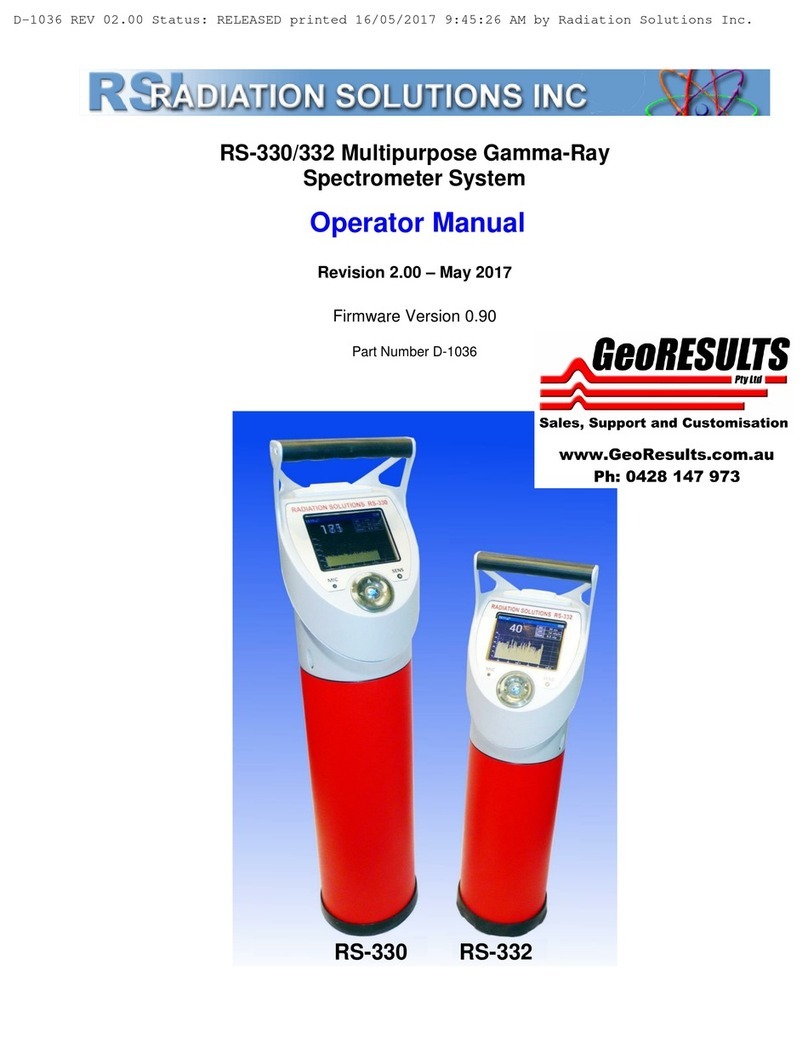
RS-125/230 User Manual –Revision 1.05
Radiation Solutions Inc –Proprietary Page v Revision Date: December 11, 2015
Table of Contents
1.0 INTRODUCTION ................................................................................................................ 1
1.1 GENERAL ................................................................................................................................. 1
1.2 MAIN FEATURES .....................................................................................................................2
2.0 SYSTEM OPERATION....................................................................................................... 3
2.1 BATTERIES .............................................................................................................................. 3
2.2 BUTTON.................................................................................................................................... 3
2.3 DISPLAY ................................................................................................................................... 3
2.4 POWER ON after BATTERY CHANGE....................................................................................4
2.5 POWER ON normal ..................................................................................................................4
2.6 SURVEY DISPLAY ...................................................................................................................5
2.7 AUDIO.......................................................................................................................................5
2.8 STABILIZATION........................................................................................................................ 5
2.9 ACTION.....................................................................................................................................6
2.10 ASSAY....................................................................................................................................... 7
2.11 REAQUIRE BG ......................................................................................................................... 8
2.12 Start RECORDING....................................................................................................................9
2.13 DATA RECORDING GENERAL .............................................................................................10
2.14 POWER OFF...........................................................................................................................11
2.15 LOW BATTERY....................................................................................................................... 11
3.0 CONFIGURATION (Manual Method)..............................................................................13
3.1 PARAMETERS........................................................................................................................13
4.0 PC CONNECTIONS .........................................................................................................19
4.1 PC SOFTWARE DOWNLOAD................................................................................................19
4.2 INSTALL RSAnalyst................................................................................................................19
4.3 STARTUP RSAnalyst..............................................................................................................21
4.3.1 RSAnalyst SYSTEM SOFTWARE.............................................................................22
4.4 MAIN MENU............................................................................................................................22
4.4.1 FILE................................................................................................................................22
4.4.2 DEVICE.......................................................................................................................... 23
4.4.3 PROGRAM..................................................................................................................... 23
4.5 TOOL BAR .............................................................................................................................. 23
4.5.1 CONNECT:.....................................................................................................................23
4.5.2 DISCONNECT:...............................................................................................................25
4.5.3 DOWNLOAD: .................................................................................................................25
4.5.4 OPTIONS: ......................................................................................................................26
4.5.5 SETTINGS: ....................................................................................................................28
4.5.5.1 DEVICE SETTINGS - TAB..............................................................................28
4.5.5.2 STABILIZATION LOG.....................................................................................31
4.5.5.3 MEMORY ........................................................................................................31
4.5.5.4 MAINTENANCE..............................................................................................33
4.5.6 ABOUT:.......................................................................................................................... 35
4.5.7 QUIT:..............................................................................................................................35
4.6 PAGE TABS............................................................................................................................36
4.6.1 CALENDAR Page ..........................................................................................................36
4.6.2 MEASURED DATA Page...............................................................................................36
4.6.2.1 DATA EXPORT...............................................................................................40
4.6.3 MAPS Page....................................................................................................................41
4.6.3.1 GENERAL .......................................................................................................41
4.6.3.2 HOW TO USE MAPS:.....................................................................................42
4.7 STATUS BAR..........................................................................................................................44
D-1009 REV 01.05 Status: RELEASED printed 18/12/2015 5:26:09 PM by Radiation Solutions Inc.




























